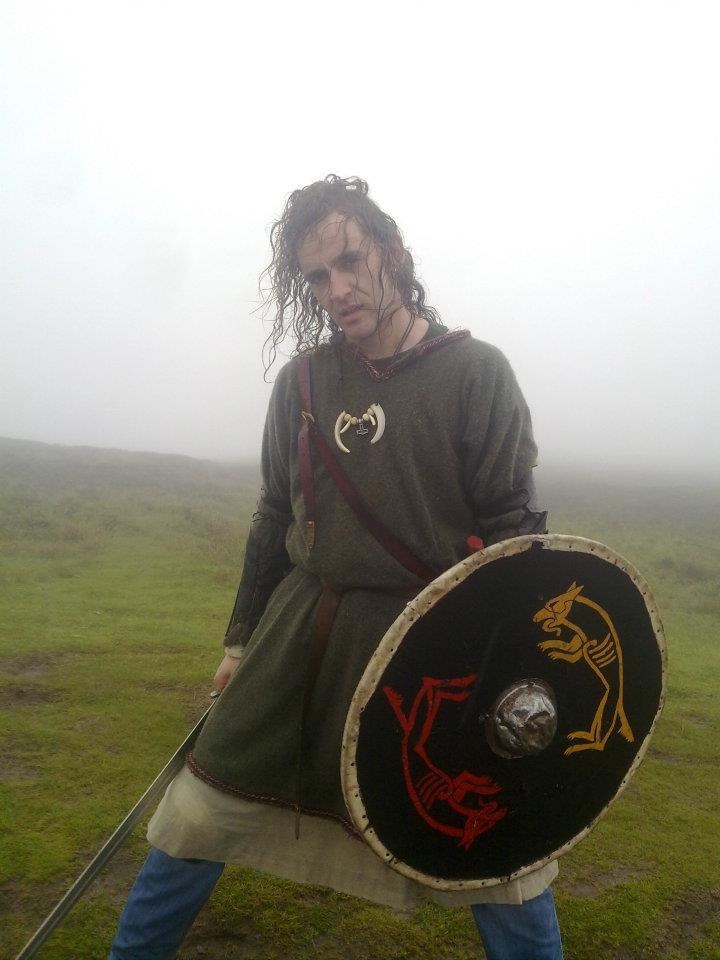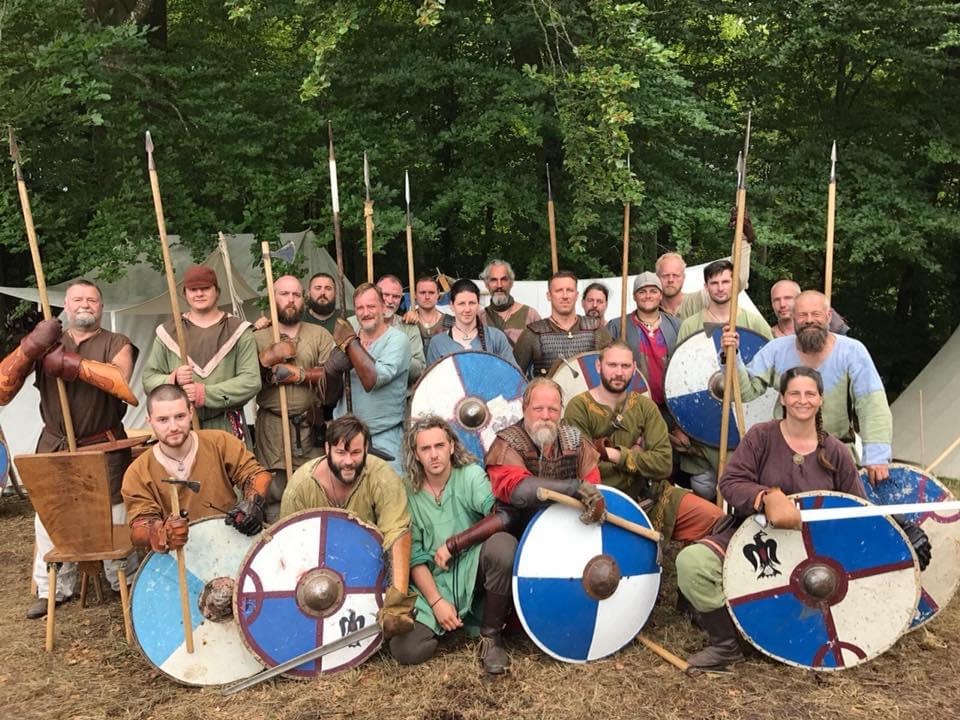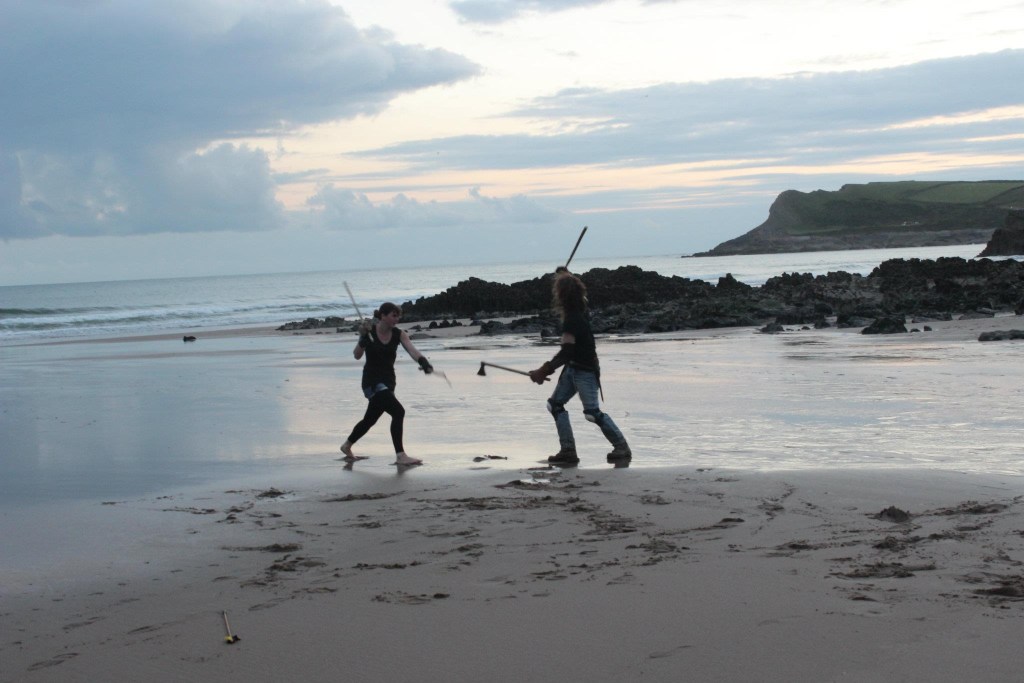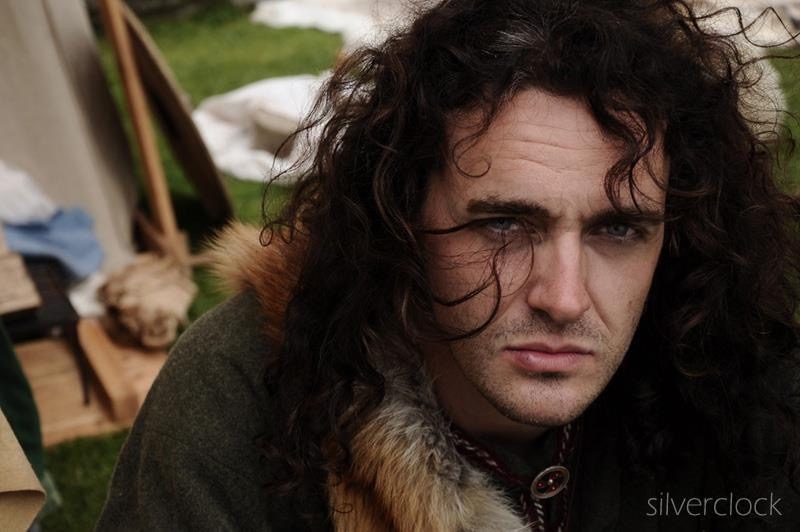I adore Steve Hildrew. I really do. With his boundless enthusiasm he’s a bit like a Blue Peter presenter before the cocaine, sex tapes and scandals. The community updates he does are a jolly five minute blast of sunshine for those us us who can’t stomach long awkward YouTube videos. He has been very supportive of my blog mutterings and asked the other day if I’d write one about how my real life wargaming experiences relate to my on-table wargaming experiences.
Real life wargaming?!?!? But Danny, I hear you cry, what madness this? Well, here’s a bit of my history….
Aside from watching plenty of He-Man when I was little and making big wooden swords to fight hordes of monsters invading across the Yorkshire fields, my first foray into the realm of fighting was spending much of my teens fencing and I even managed to get a few unimpressive trophies for my talents. My focus then turned to martial arts and after four years of dedicated pain I managed to get my Black belt in Aikido. At that point, life in Yorkshire seemed harrowing to me and I fled to the big city (well, Guildford) to play in a rock and roll band which didn’t leave much time for fighting.
Then one day a buddy of mine took me to the back of his van (I’ll admit he is a bit odd so this could have gone one of two ways) and it was full of swords and shields and spears. Proper metal ones. Childhood Danny’s heart leapt! So I bought my first sword from him in a pub and had to walk home past the police with it hidden down my trouser leg.
14 years on and I’ve done hundreds of viking re-enactment shows and training every week with a multitude of weapons (though specialising in two weapons and pole axe), been in documentaries, small movies, on stage with the Darkness, rowed a viking boat 30 miles down a river, stunt work with horses, and done huge shows with hundreds a side. The English shows started to annoy me so I turned to the European style which is far less anally retentive and more focussed on the competitive side. I have hundreds of stories and adventures to tell.

So you came here to read about Kings of War, and strangely they both have a lot in common. In a previous blog I talked about cheating. We play both on an honour system. If you lose, take a hit then you have to accept it. Arguing isn’t a good thing. You learn from your mistake and try not to make it in the future. The main difference is that if you don’t take a fair hit from a fighter you’ll piss them off. We fight with blunted weapons with the aim of hitting your opponent in a target zone (nowhere dangerous like the face) hard enough so they feel it but not so hard that you hurt them. Because if you do ignore hits then you can pretty much guarantee that the next hit is going to come in harder. And if you get a reputation for it then soon you’ll become a target for every spear in sight and walk away looking like a Dalmatian. You won’t think that you’re immortal for long and humility will get you in the end. No matter how good you are at a game you will lose sooner or later. There’s always a bigger fish and you can’t rest on your laurels because little fish get bigger and big fish get older and slower. The rankings in Kings of War are a great way of seeing this as to who the fish are. The last three years from my first Kings of War tournament I’ve steadily climbed my way up the tournament listings and you only get better by fighting people better than you and learning from them. One day you beat that fighter who you know is far better than you. Its the same feeling as beating a gamer you know is a regular tournament winner and masters player.
One of the main things you have to keep in mind of both hobbies is the suspension of reality. They are both after all, just games. Though we fight for real with steel weapons, it’s not for real. The weapons are blunted to agreed safety standards and rules (eg. My dane axe is not allowed over 200 cms) and we have safety zones for different weapons to avoid injuries. In viking times the vast majority of wounds were to the face. It’s a product of that way of war, fighting in shield walls, but we can’t do that so we adapt it to a set of rules. It has to be balanced between realism, safety and competitiveness much like in Kings of War (not the safety part though unless you’re REALLY bad at dice rolling!).
There had to be the question ‘What is the best way to represent this action?’.
Kings of War is a ruleset that governs how an army fights on the tabletop and the rules have to represent what is happening. There has to be a limit as to how far it goes and a battle has countless variables to its outcome. We have to remember that Kings of War is a MASS combat game. It’s all about units. Actual regiments and hordes of troops and the rules represent that. You can add in psychology, you can add in individual model attacks, you can add in the weather, you can add in how hungover the army is (in the Viking world this is a brutal, hideous and common factor) and you can add in thousands of variables but that doesn’t necessarily make for a good mass combat game. And we’re not just talking human variables. Add in magic, monsters, flying etc and it’s a minefield on how to put those variables into a fun, fair game.
Many fantasy stories talk of mighty wizards that can decimate entire armies. Epic to read, boring in a game. Unless you’re in charge of the wizard and you were bullied as a child that is.
So lets look at a couple of rules in kings of war and see how good I think they are based on my experiences…..
Thunderous Charge when charging off a hill….. I hate it. If you’ve ever had to run down a hill at an enemy at speed then you will know that it’s a death trap. Especially on damp grass. You’re more likely to end up falling on your arse or worse and it’s harder to control your attacks and when you finally get to the bottom the entire attack will be rag tag and disordered. But hills ARE an advantage if you’re at the top and the enemy have had to march all the bloody way to hit you. I’ve fought at Hastings on both sides in 30 kilos of armour and it’s exhausting getting up that hill! But sitting happy on hills doesn’t make for a fun war-game game and giving an advantage to sit there is boring and overpowered. The thunderous charge solution switches it around and makes it more dynamic. Not accurate, but a solution nonetheless to benefit the game.
Flanks and rear charges are king. Double and treble attacks are perfect representations. We fight in shield walls and you can’t ignore the enemy to the front. One of the main aims is to get warriors around the back. By punching through or getting runners around the side and through the gaps to attack the rear. We position our own runners and rear guards to deal with the threat much like in Kings of War. It’s bloody hard to find a gap to get through and mostly you have to wait until later in the battle when numbers are thinned to take advantage but when you do get behind it’s fast and vicious work. I’ve taken out 10 plus fighters many times by getting in the rear. You’ll probably die but you can take out many more of the enemy and make gaps for your main fighting line to win. Basically you use yourself like chaff to put your main unit in a position to win the fight. In one of the photo’s you can see me (the lime green tunic and gorgeous hair!) skirmishing and threatening flanks and the Danes positioning their own ‘chaff’ to protect their flanks. It doesn’t have the same clean lines as the tabletop but the essence is the same.

Nimble is fairly accurate too. When you’re not constrained by heavy armour or ranked up formations then you have a lot more options with how you can move. The same with pathfinder. Most train to fight as a group, using each other to support and guard you but as soon as you have to move at speed or you’re split up by terrain then those advantages are hindered and faster, more agile troops that are used to the terrain have a massive advantage. I’ve done a lot of skirmish fighting in the woods, and fallen trees, bramble patches and agility are as much a weapon to winning as a sword. Hit and run attacks draw out troops to be exposed and you can pick off the enemy one at a time before the others can get to you. Much like Kings of War you can force a much larger, stronger force to just stand there unable to do much because you have put faster, more mobile troops into a position where they can’t be ignored. They’re not killing but they’re winning the game because if that stronger enemy unit is too busy dealing with chaff then they’re out of the game and the rest of your army has an easier job.
In Europe they don’t use bows but in England they use lighter arrows with rubber tips and low poundage bows (hurts the same as a paint ball) and when there are archers on the field you either have to be really fast or hide behind big shields to stay safe. In essence, you expose your chaff then it’s going to get shot off! Obviously we don’t use artillery. Well, there was this one time on a beach in Denmark at 4 in the morning where a drunk Danny thought it was a brilliant idea to fire himself from a trebuchet into the sea. Unfortunately I wasn’t able to get the arm down on my own and more sober, less spirited folk stopped anybody from helping me. I still maintain it would have worked. But the way that we deal with artillery in Kings of War by sending a fast hero through a gap to take them out is essentially the same. If you’re a runner you find that gap you get through and go as fast as you can to the archers and take them out before you get got and work your way through them.
I can’t comment on magic. Or flyers. Or monsters. Large infantry…. Well, a couple of the Icelandic guys are titanic. I’m happy they’re playing a game because I would never want to have to stop a full blow from one of them.
Cavalry I have been around. A charge from them easily earns the thunderous (2)! Obviously we can’t use them in competitive fighting, indeed it takes a lot of training to get them to do skirmish displays and I’ve done plenty of stuntwork with them. Even the smaller Icelandic horses can knock you flying with very little effort. When you look at big police horses, the modern equivalent of a charger then the amount of power they have is immense. I remember seeing a video during the rioting in London years ago where the MET Police actually did a cavalry charge to disperse the ruffians. It was beautiful. But put a line of spears in the way and you can see how well phalanx works too.
Chariots are an odd one. Never seen one in action but one thing that always annoyed me in 2nd Ed was how many shots they got. In a chariot of 2 guys, one of which drives leaving one to shoot. So 6 chariots, meaning 6 guys means 24 shots? Thats insane! Luckily they solved that for 3rd Ed and they’re much more balanced now. An odd thing is Nimble on single chariots. If a chariot crashes into an enemy unit then it’s not easy to reverse and spin. It will do well on the charge but quickly get clambered over and overwhelmed. We’re back to the the thinking of how to represent things. A chariot attacks a unit but rather than crashing headlong they steer and go across the front, giving the crew chance to hit sideways and attack the front of the enemy as it passes. This carries on the momentum and represents the ability to disengage and ‘nimbly’ drive off to attack something else. It doesn’t look like that on the tabletop but otherwise we get into the situation where you have to throw in loads of extra rules to deal with the variables. This is simple and elegant and doesn’t bog the game down.
In Warhammer there were many rules for psychology, fear, panic, frenzy etc and the rules were fairly well representative of the field. Kings of War bundles them simply into the waver rule. If you’re taking a kicking and losing fighters left right and centre, or if you’re being sent into a situation you know full well is stupid then you have a tendency to pause and reevaluate. And pausing and reevaluating when you have several guys trying to hit you isn’t an ideal situation and your focus goes and you lose. Waver is a simple way of representing that. Inspiring works in a similar fashion. Having tough guys behind you shouting “get the fuck in there!!!”, which, not necessarily ‘inspiring’ certainly provides incentive. I once tried LARP and despite the costumes and big rubber monsters being fun it was ultimately ruined for me by the actual LARPers. Nerds, man….. Self importance and shiny armour doesn’t make you a mighty warrior.
We do play actual war-games too. We do many different games to change and focus training, team games, defend the bridge, pushing games, respawning, objective taking etc in much the same way we play scenarios on the tabletop. In actual competitive battles it’s mainly a straight ‘kill’ scenario but battle plans based on available units and terrain are all brought into consideration.
Well, I could go on for hours but it’s getting quite a long read as it is so that’s my fair comparison. I’d love to run away from Dragons. I’d love to cut through hordes of evil rat men. But I love what I do and I get to play both ways and enjoy them equally for different reasons. Balance is important in life! And above all, it is just a game we play for fun.













this article is awesome. I love the examination of KoW rules, comparing them to both the experience on the table and your own, unique experiences! Its very cool.
I also agree Steve Hildrew is amazing!
LikeLike